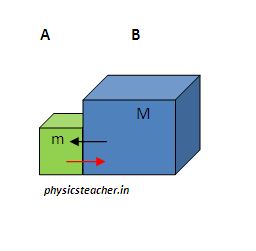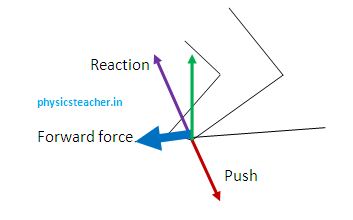Newton’s Third Law of motion – concepts and examples
Last updated on October 2nd, 2023 at 04:23 pm
Newton’s third law of motion states that to every action there is an equal and opposite reaction. This means for every action or force exerted by the first object on the second object, there will be a reaction force that is equal in magnitude and opposite in direction to the action force. And this reaction force is exerted by the second object on the first object. This law is also phrased as Newton’s 3rd law.
If we take a specific example: If object A exerts a force F on object B, then object B exerts a force –F on object A. The negative sign indicates a direction opposite to that of the F action.

Action Force Versus Reaction Force – they don’t cancel each other
The action-reaction forces always act on different objects as per Newton’s third law. In the above example, the action acts on object B and the reaction acts in turn, on object A.
While drawing a free-body diagram, only one of the action-reaction pairs of forces would be drawn for a given object. The other force in the pair would appear in the free-body diagram of a different object.
As a result, the two forces do not cancel each other. In the above example, the action force would be drawn on the free-body diagram of object B and similarly, the reaction force would be shown on the FBD of object A.
Contact forces: Analysis with Newton’s Laws
The three rules obeyed by 2 forces in the 3rd Law pair are: the forces must be of the same type of force, they are exerted on two different objects and they are equal in magnitude and oppositely directed.
One interesting example of third law pairs: A block sits on a table. The Earth’s gravity on the block and the force of the table on the block are equal and opposite. But these are not the third law pairs, because they are both on the same object and the forces are of different types. The proper third law pairs are: (1) earth’s gravity on block & block’s gravity on earth and (2) table pushes on block & block pushes on the table.
Newton’s third law example – Action Reaction Forces examples
Walking and Action Reaction Pairs Examples

When we walk we apply force on the ground. This is an action force. The ground in turn applies an equal but opposite force (Reaction) which helps us to walk.
Details of this are available here with Free Body Diagrams: How friction helps in walking
Feeling Weight & Third Law of Motion examples
As we stand on the floor we can feel our weight. This feeling of weight is provided by none but the reaction force given by the floor on us in return to the action force (our weight) which acts towards the center of the earth.
So basically the feeling of weight only comes when a surface provides a Normal Reaction force to the body resting on the surface.
You can get a better understanding from this post: A few Elevator case studies
Not Feeling Weight in Free Fall
However, while in free fall (considering zero air drag) the weight of the freely falling body equals the gravitational force between that body and the earth.
During free fall there is no immediate surface under the body where the weight gets applied (air resistance taken as zero) as an action force.
Therefore there would be no reaction force as well. So the feeling of weightlessness erupts here.
Details you can find here: Weightlessness.
A few more examples of Newton’s 3rd Law
Acceleration of car
A car accelerates from rest as the car’s engine turns the wheels. The tires exert a force on the road. By the third law, the road exerts an equal and opposite force on the car’s tires. This reaction force which acts on the car through its tires, takes the car forward. The force exerted by the tires on the road does not accelerate the car.
Rocket – Helicopter – birds – aeroplane
The rocket exerts a large force backward on the gas in the rocket combustion chamber, and the gas in turn exerts a large reaction force on the rocket in the forward direction. This reaction force is called thrust. Thus rockets move forward by expelling gas backward at high velocity.
Helicopters push air down and experience an upward reaction force.

Birds and airplanes also fly by exerting force on air. For example, the wings of a bird force air downward and backward in order to get a lift and move forward respectively.
Acceleration of objects under Action-Reaction forces – Newton’s Third Law
Since the action-reaction forces act on different objects, they generally produce different magnitudes of accelerations (considering the objects are of different mass) for the object pair.
The accelerations produced would have opposite directions, but please note that we are talking about the magnitude of the accelerations only.
Acceleration of an object = force applied on the object/ mass of the object.
a stone falls back on the ground
When a stone is dropped from a height it exerts a force on the earth that is equal and opposite to the gravitational pull the earth exerts on the stone. Here any one of these force pairs can be taken as action and the other one becomes its reaction.
Still, the stone falls on the earth before the earth moves upwards to grab the stone. This is because the stone has a much higher acceleration than the earth in this scenario.
Details of this are available here: a stone falls towards the earth but the earth doesn’t.
Contact forces between 2 blocks: Analysis using Newton’s Laws

To read the article in this portal, pls follow the link: Contact forces between 2 blocks: Analysis using Newton’s Laws

